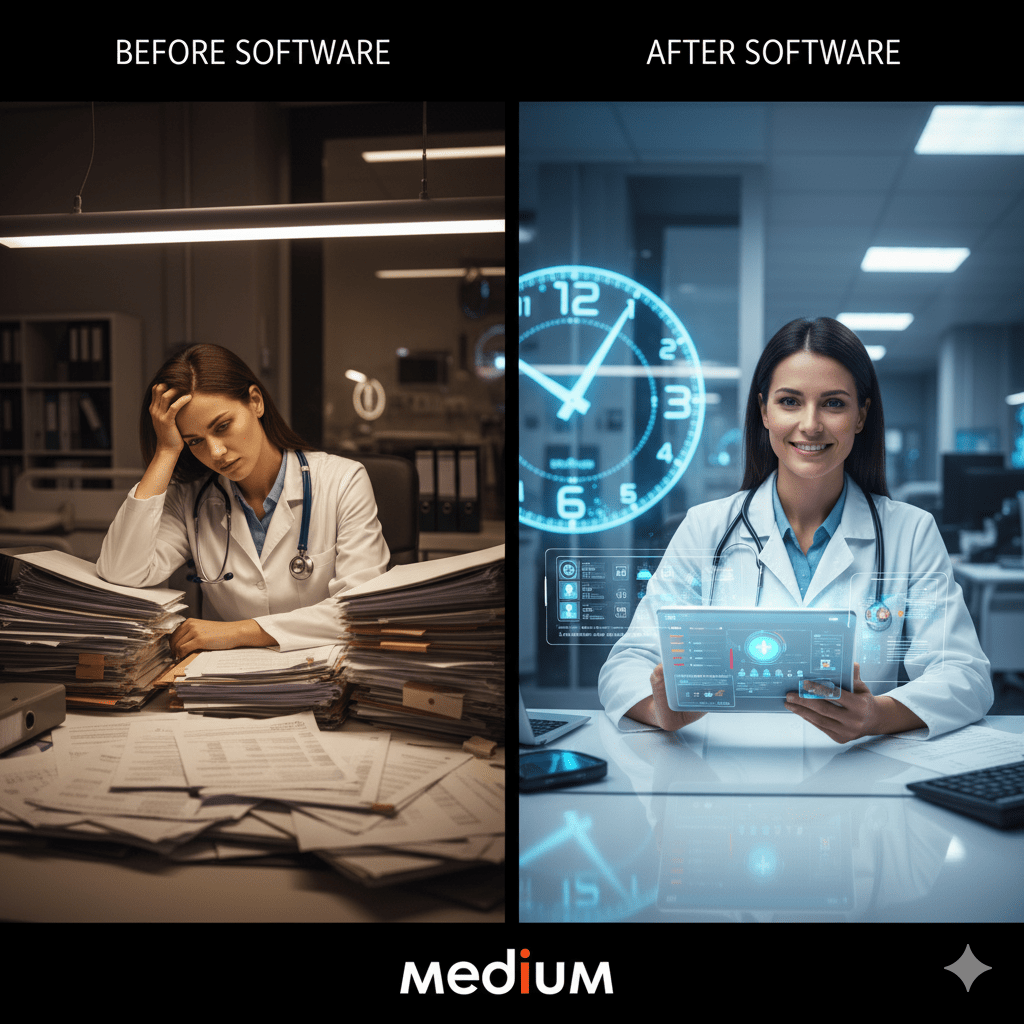Every doctor knows that medicine is about people, not paperwork. Yet in today’s fast-paced healthcare world, physicians often spend more time managing administrative tasks than actually treating patients. From endless charting to scheduling follow-ups and dealing with billing complexities, the burden of non-clinical work eats up valuable hours every day.
But now, technology is stepping in as a silent partner to change that. Advanced medical software systems are freeing doctors from repetitive, time-consuming tasks, allowing them to reclaim hours once lost to manual processes. This digital transformation is reshaping how healthcare professionals manage their days and, more importantly, how patients receive care.
1. The Administrative Overload Doctors Face
Before diving into how software is helping, it’s important to understand the problem. Studies have shown that doctors spend nearly two-thirds of their time on administrative duties. This includes patient documentation, insurance claims, data entry, and follow-up tasks that, while necessary, don’t directly improve patient outcomes.
These responsibilities not only reduce productivity but also contribute to burnout, a growing issue in healthcare. Many doctors feel overworked, stressed, and unable to dedicate the personal attention their patients deserve. This imbalance has made efficiency tools not just helpful but essential for the survival of modern medical practice.
2. Enter the Digital Assistant: Healthcare Software to the Rescue
Healthcare management software has evolved into a powerful ally for medical professionals. From Clinic Management System (CMS) to Electronic Health Records (EHR) and Telemedicine Platforms, these digital tools automate, streamline, and optimize nearly every aspect of practice operations.
Instead of manually entering patient information, doctors now use smart systems that auto-populate data, synchronize appointments, and generate prescriptions instantly. This seamless integration of tasks means fewer hours spent on paperwork and more time focusing on what really matters the patients.
3. Smarter Scheduling and Reduced No-Shows
Appointment scheduling once required constant phone calls, paper logs, and endless rescheduling headaches. Now, intelligent scheduling software has changed the game.
Modern systems allow patients to book, reschedule, and cancel appointments online, while doctors get real-time calendar updates. Automated reminders via SMS or email reduce no-shows, ensuring better time management throughout the day.
Moreover, advanced analytics can even predict patient flow and suggest optimal time slots, helping doctors plan their day more efficiently. What once took hours of coordination now happens automatically, saving doctors both time and frustration.
4. Effortless Documentation Through Electronic Health Records
EHRs are among the most transformative tools in modern medicine. These digital systems replace bulky paper files with instant access to patient history, test results, and treatment notes, all in one place.
Doctors can record consultations digitally through voice dictation or smart templates, drastically reducing time spent on manual entry. With a few clicks, they can review lab reports, prescribe medications, and share updates with other specialists.
This not only speeds up the consultation process but also ensures accuracy and continuity of care, since every detail is safely stored and easily accessible.
5. Automated Billing and Financial Clarity
One of the most tedious aspects of running a clinic is managing billing and insurance claims. Errors, delays, and follow-ups can consume hours of administrative time each week.
Medical billing software automates the entire process from invoice generation to payment tracking and insurance verification. Doctors no longer need to chase payments or double-check calculations; the system does it all, providing real-time financial transparency.
This efficiency not only saves time but also ensures a steady cash flow, reducing financial stress and allowing doctors to focus on patient care rather than paperwork.
6. Virtual Consultations: Time Efficiency Redefined
The rise of telemedicine has further revolutionized healthcare delivery. Virtual consultations enable doctors to attend to more patients in less time, without the delays of travel or waiting rooms.
With integrated telehealth platforms, doctors can consult, prescribe, and document cases remotely. Follow-up appointments and lab result discussions can be handled online, freeing up clinic hours for more critical cases.
Patients benefit too quicker access to doctors means faster recovery, and fewer missed appointments.
7. Data-Driven Insights for Smarter Decisions
Modern medical software doesn’t just store data it analyzes it. Using AI-powered analytics, doctors can now gain valuable insights into patient trends, common health issues, and treatment outcomes.
For example, a physician can identify which patients are due for checkups or which medications are showing better results. This allows for proactive care rather than reactive treatment, improving efficiency while enhancing patient satisfaction.
Such insights also help in resource planning, ensuring every hour and every appointment is optimized.
8. Reduced Stress and Improved Work-Life Balance
By automating repetitive tasks, healthcare software doesn’t just give back time it restores balance. Doctors can finally leave the clinic on time, spend evenings with family, or dedicate hours to research and learning.
This improved balance translates into better focus, sharper decision-making, and a more empathetic approach toward patients. In the long run, technology becomes not just a productivity tool but a wellness companion for healthcare professionals.
9. Real-World Impact: Clinics That Transformed Their Workflow
Across Pakistan, clinics and hospitals adopting Clinic Management Software are witnessing measurable improvements. For instance, a mid-sized clinic that integrated digital scheduling and EHR tools reported saving up to 3 hours daily per doctor, time now invested in more patient consultations and quality care.
Hospitals implementing automated billing and patient tracking systems also reported reduced administrative costs and faster service delivery. These results show that embracing digital healthcare isn’t just a luxury, it’s a necessity for sustainable growth.
Conclusion: Giving Time Back to Those Who Give Care
In healthcare, every minute counts not just for patients, but for doctors too. By automating routine tasks and simplifying complex workflows, software solutions are giving back hours to every doctor’s day. These hours translate into more patient interaction, better decision-making, and improved overall well-being.
The future of medicine isn’t just about advanced treatments, it’s about intelligent systems that empower doctors to do what they do best: heal, connect, and care.
If you’re a medical professional looking to experience this transformation, explore how modern healthcare software can streamline your practice and bring balance back to your day.












Leave a Reply